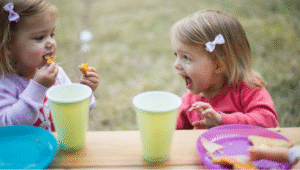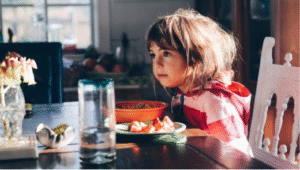Food Therapy for Kids: Why It’s Changing Lives in the 21st Century
Food therapy for kids is more than changing what’s on the plate. It is a journey of improving, developing and prospering with each bite. Children in the 21 st -century are usually problematic in relation to food, emotions, and behavior. Food therapy demonstrates to parents the way nutrition and table conditions influence physical and emotional health of a child. It can make kids happy to eat, feel secure about food and become more friends with food. Food therapy is the real hope, healing and happiness regardless of whether your child has picky eating issues or sensory issues.

What Is Food Therapy for Kids? Understanding the Basics
Food therapy for kids is a treatment that focuses on how children eat, react to food, and use it to grow healthier. It’s helpful for children who won’t eat, chew wrongly, gag a lot, or have texture issues. Therapists try to explore smells, tastes and texture of food with children. Nutrition is just the tipping point: confidence, safety. What is food therapy for kids? A holistic approach to nourish the body and brain, through food to emotional connection and physical development.
Lots of the time kids have secret fears or control problems around food. Therapy sessions gradually teach them new eating ways while lessening their anxiety. Parents too learn how to make fun, relaxing meals. For many it is life changing.
Food Therapy for Kids with Autism – A Gentle Path to Progress
Parents request food therapy in a large number of children with autism. Children with spectrum disorder are usually overwhelmed with food: colors, smells, and textures are too much. Others just eat little or go without eating. Food therapy includes new foods gradually but safely in play, games and individually.
Counselors make quiet rooms, offer clear images and repeat every action. Such measures make children become prepared to eat unfamiliar foods. After some time, fear is changed into interest; interest is changed into habit. The alteration is not only nutritionally beneficial but also benefits the ways children relate to in-home meals and school cafeteria. Solving food ends up as a great victory in many families.

Food Therapy for Autistic Kids – Step-by-Step Hope
When treating a child with food therapy, we concentrate on one child at a time using trust and guidance. Due to sensory or emotional feelings, autistic children tend to shun food. Therapists observe and comprehend rather than make them eat. They develop the plans involving enjoyable games, images, and exposure to new dishes slowly.
Children are not the same. One size cannot fit all. Food therapy takes notice of such differences. As an example, some children will be consuming white foods or crunchy foods only. It begins with therapy, which pressures not at all but only advises. Such care does not only enhance their diet but also contributes to eliminating meltdowns, fears, and food anxiety.The voice of many families is that this transformed our life.

The Emotional Side of Food Therapy for Kids
Food is not just fuel. It can also activate our emotions. When a child refuses to eat dinner or feels stressed at the table, it is unlikely that there is nothing behind it. With a patient attitude, food therapy reveals that story. It makes the child trust food once again and makes parents realize the needs of the particular child.
Other children are traumatized or hurt during meal time. Maybe they acquired the behavior of a picky-eating sibling.Most families keep wondering why their child is not able to eat like the rest. Through food therapy, it gives peace of mind. They do not behave like that out of fault. It is a mere start to a better journey.

How Sessions Work in Food Therapy for Kids
The therapists initially observe the eating pattern of a child, food reaction and behaviour during meals. Then they develop a personal plan. Such sessions can combine:
- No gum.
- Specific exercises (assisting in chewing or swallowing exercises) (oral motor exercises)
- Rituals of relaxation to ease breaking gastric anxiety
Home strategies and parent coaching
Each action is child oriented, non demeaning and joyous. This will create good associations towards eating.Visiting therapists also employ charts, music and stories to make the kids feel relaxed. Gradually, children usually switch to the position of “okay, I will give it a shot.”
Signs Your Child May Need Food Therapy
Does your child have eating problems? You may find yourself shaking your head and telling yourself, it is a phase. However there are moments when a period becomes a trend.Such symptoms may indicate not a temporary problem:
- Your child consumes less than 10 varieties of foods.
- Gagging, spitting or crying is done by your child when you present new foods.
- Your child shows preference to foods or textures.
- Your child does not want to eat at school or places of social gathering.
- Your child will look thin, take time to grow or experience other issues with nutrition.
- Meal times give your child anxiety or anger.
In case one of these symptoms appears, contact a medical worker. You should not allow the problem to deteriorate.If any of these sound familiar, food therapy for kids can help—gently, safely, and positively.
The Parent’s Role in Food Therapy for Kids
You are not just a care giver, you are the superhero in the life of your kid when it comes to food. In food therapy, the parents are instructed on how to assist in the home meals. you will find:
- The way to make a serene eating environment
- The advantage of pressure-free meals
- Exposure games Fun food
- The way to model good food behavior
Most parents give the same answer, that the therapy alters their opinion, as well. Remember this line from many experts: Bad Therapy—why kids aren’t growing up fast enough often comes from ignoring their emotional needs. Food therapy listens to those needs with care.

Why Early Food Therapy for Kids Matters
The quicker you get started the easier it is. Young brains are plastic. They learn quickly. Early treatment may be able to:
- Avoid long term eating disorders
- Improve concentration and energize school performance
- Gain confidence meals out
- Supports Total development & Brain Highlight
A child that begins therapy at 4 may be preventing multiple years of stress in the future. Think about it like brushing your teeth, regular to proper care keeps the foundation healthy.
Food Therapy vs Picky Eating: What’s the Difference?
Picky eaters are not all identical. Others are children who are yet to discover what they like and what they do not like. There are others who are experiencing actual feeding pains. Food therapy for kids can sort this out. Therapists understand when a picky phase is normal as opposed to a feeding disorder.When your child fails to improve even after following the basic parenting concepts then you may require assistance. Intensive therapy does not bring love in place it merely brings a new set of equipment in the parenting tool kit.
It is not about how to fix your child. Rather, therapy makes you know more about your child.
Helping Picky Eaters Thrive with Food Therapy for Kids
Many children are picky eaters, but this behavior can cause stress during each mealtime. Food therapy for kids helps parents understand why picky habits form and how to guide change in a gentle way. Children can refuse the foods due to the flavor, the smell, or the texture of the food. Therapy changes the fear to interest.
Children are taught how to touch food slowly and how to taste or smell it. This eliminates fear and creates positive associations to food. Therapists apply entertaining means such as songs and stories, and food art to improve self-esteem. Picky eaters can succeed with time, support and patience.
How Schools Benefit from Food Therapy for Kids
Food therapy is now provided by a lot of schools to children when visiting a speech therapist or occupational therapist to attend an OT visit or to see a counselor. Therapists in schools monitor children during snack periods or lunch. In case a kid does not eat and now refuses, chokes, or even carries a single food per day, this can serve as an indication that they require assistance.
Therapists meet the parents and the teachers after viewing this. They construct a plan and offer the child support in a non-threatening, secure location. Collaborating with a child enables him/her to find pleasure in eating at school and develop social eating skills. When the school partners with the parents, the kids are empowered in all aspects.

Tools and Toys Used in Food Therapy for Kids
Food therapy for kids uses many creative tools. They are food-shaped puzzles, chew tubes, feeding spoons, sensory bins, and textured plates. Those are not mere toys as they are educational tools that enable children to learn about food in different ways.
An example is a child scared of squishy foods who holds the mashed potatoes with a toy, prior to feeding on it. Some other children can use a textured straw in order to train their mouth muscles by chewing it. These educational tools are entertaining. By the use of play, children become more receptive to food.
Turning Mealtime Fear into Trust with Food Therapy for Kids
All children ought to be safe around food. Eating is however scary or stressful to some people. Food therapy for kids can be a lifeline because it moves children from fear to fun, from saying “no” to making tiny wins. Therapy, however, can in a very patient, considerate manner transform mealtimes into occasions of love, healing, and trust.
How to Start Food Therapy for Kids at Home
You should not wait to know all the details of an expert to start. Today there is some basic food therapy which can be applied in home. Start with:
- Allowing children to play with food.
- Providing new items along with favorite ones.
- Making a stress free food area.
- Applause at any movement, smelling, touching, and licking.
The most important thing is to remain composed. Food therapy for kids works best when the home is safe and loving.
Why Doctors Recommend Food Therapy for Kids Today
Parents are also advised to use food therapy, sometimes by doctors when the normal feeding suggestions fail. The issues may harm growth, academic performance and mood. Food therapy also works smoothly to ensure that there is a change in eating habits but not with so much stress.
Food therapy is believed by doctors since evidence proves it. It is not just about food but it also heals the entire child. When food improves, the sleeping process, concentration, and mood improve too.
Success Stories from Food Therapy for Kids
Food therapy has the chance to transform the lives of families. Even cracker eating children began to taste fruit just after several weeks. The other who feared the meals also joined the family dinner happily. There is actual improvement evident in these stories.
Every step is celebrated by therapists. A single bite, a smile at the dinner table, or biting a new kind of texture may mean massive success. These victories remind people that given time, affection, and assistance, children have a chance to become powerful and cheerful thanks to food therapy.
Final Thoughts: Real Growth Through Food Therapy for Kids
Food is living. Dinner is a battle for some children. Food therapy for kids makes meals peaceful again. It makes children safe, respectful, and curious once again. Parents are educated on how to facilitate growth with no fear and stress.
Autism through trauma and sensory problems or simply bad habits, food therapy provides a good and robust path out of any problem with kids.
It is not speedy. But it is not a joke. It is painstaking slowness, the slowness that is craft caring.
✅ FAQs About Food Therapy for Kids
Q1: What is food therapy for kids, and who needs it?
Food therapy for kids is support that helps children eat better through fun, gentle learning. It helps children with food aversion and kids with chewing or texture issues, and anxious children. This type of therapy is helpful to many kids, even though they have minor problems.
Q2: How does food therapy for kids help children with autism?
It takes up safe, slow measures in order to make food seem fair once again. In children who have an autism problem, treatment reduces sensory anxiety. It assists them in the new food discovery with sight, smell, and texture games. This is aimed at establishing trust, rather than imposing.
Q3: How long does food therapy for kids usually take?
This is dependent on the child. Others will get better in weeks, some will take months. It is the little-by-little thing. With food therapy for kids, small changes build lasting success. First time support is normally quicker.
Q4:Can food therapy for kids be done at home?
Yes! Such home tips as food play, calm eating, and praise can be used by parents. However, in the case of greater challenges, a trained therapist achieves optimal results. A combination of home and clinic care is suitable for most families.
Q5: Is food therapy for kids the same as feeding therapy?
They differ quite little. They both assist the children in learning how to eat healthily. Swallowing and motor skills happen to be the greater emphasis of the feeding therapy. Food therapy for kids may also explore emotions, textures, and behaviors linked to food.

